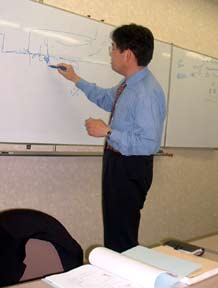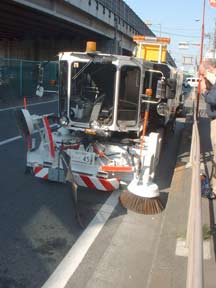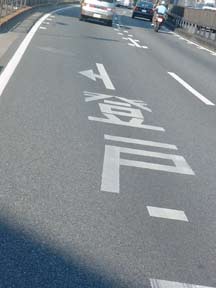Sweeping in Japan

Sweeping in Japan |
 |
Roadway sweeping and the Ministry of Land, Infrastructure and Transportation in Japanby Ranger Kidwell-Ross
Hiroshi Hashimoto, president of longtime Tokyo sweeping contractor, Kyoei, arranged a meeting in their offices with Masatoshi Sakai, a representative of the Ministry of Land, Infrastructure and Transportation, Japan's 'lead agency' when it comes to roadway sweeping. As I suspect is customary procedure for any meeting of substance hosted by the impeccably gracious folks at Kyoei, we all started off with a nice cup of tea. In Japan, that drink is the counterpart to the coffee addiction we have in the States. The tea, green in color, was delicious. 
When it seemed appropriate to begin the actual business part of our meeting (normal 'small talk' was impossible due to the language difficulties), I first asked Mr. Sakai -- via Kyoei's general manager and English interpreter, M. Shibata -- to provide me with an overview of sweeping as far as his agency was concerned. "What," I asked, "are the main problems associated with roadway sweeping in Japan?" "Our number one problem while sweeping is traffic congestion," answered Sakai. "Because of our high density of traffic and population, it's difficult to find a time to sweep when it's safe to run the sweepers and when we can clean effectively. There's also the quality of cleaning we should be aiming to achieve. It's very difficult to decide how often to clean a particular roadway. For example, we now sweep the roadways in and around Tokyo twice per week. Whether that's often enough, or too often, is up for debate. "Then, once we've picked up the debris, another concern is what to do with the material after we've collected it into the sweeper. 
These concerns sounded all too familiar to me. Sakai had just hit upon what may be the one-two-three of roadway sweeping in America, as well. His next comments, though, introduced a new realm of information. His agency is moving toward installing porous pavement throughout its jurisdiction. The surface is seen as having a number of advantages. Foremost appears to be minimizing surface water on roadways, a major cause of traffic accidents. However, the citizenry failed to get excited about spending 10 times more to re-pave for that reason alone. In fact, the public acceptance of the movement toward porous pavement lies in the fact that it appears to reduce traffic noise by 2 to 3 decibels. Further down the list of public concerns -- perhaps due to lack of information on the topic -- are the benefits of porous pavement on reducing the storm water runoff pollution. One problem with porous pavement is that, when its pores clog up, it quits working. Although pressure washing the surface is a possible solution, it is costly. It seems obvious that air sweeping will keep the pores cleaner than using the traditional broom sweepers, but there hasn't been hard evidence generated to prove it. So, studies are currently being conducted to determine the best types of sweepers for cleaning the porous pavement. Kyoei's Schwarze EV sweeper -- because it uses no water and has an air pickup system -- may be a solution in that regard. 
The Schwarze EV is involved in such a study on a stretch of roadway not far from the office where Kyoei parks its sweepers. For the study, one side of a highway is swept every week by a broom sweeper, and the other side is swept by the EV machine. Once a month, testing is done to determine the pavement's ability to have water flow through it. This involves using a hollow cylinder measuring several feet in height and about 3 inches in diameter. The testing apparatus seals it to the pavement surface in a predetermined number of places on each side of the roadway. Once sealed to the surface, the tube is filled with water, and the length of time it takes for the water to drain from the tube is calculated and charted. Kyoei also weighs the material picked up by the EV, in order to compare it to the amount retrieved by the broom sweeper. A determination has recently been made that the current testing area may not be long enough to generate good statistical results, so there is currently a movement underway to begin another test, this time on a 30km stretch of highway. 
The porous pavement issue is changing the face of sweeping in Japan. Due to the introduction of that surface, the government is expending a substantial amount of money to find out what type of sweepers, and sweeping at what frequency, will maximize its long-term investment in the new pavement type. At the same time, they are taking a look at the volume of material picked up by different sweeper types. While there, I made sure Mr. Sakai had the information he needed to find out more about the small-micron pavement pollution problem we're concerned with in the United States, and he showed substantial interest in that, too.
This story was one written during our editor's trip to Asia in 2001 to investigate sweeping. While he was there, Ranger wrote an online journal for the sweeping industry. You may still view this online journal, which won a U.S. APEX Award for Online Journalism, in our archives.
|